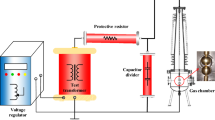Abstract
Sulphur hexafluoride (SF6) is the gaseous dielectric the most widely used in high-voltage and very-high-voltage electrical equipment. As SF6 is a synthetic gas that is expensive and could have a non negligible impact on environment, the current trend is to reduce its quantity in electrical equipment by mixing it with natural gases such as air or N2. Such a mixture is envisaged for gas-insulated transmission lines, particularly for very high voltage network where a high power is necessary. Until now, transmission lines have been insulated with pure SF6 at a pressure of 400 kPa. They could soon be insulated with a SF6-N2 mixture with a high proportion of nitrogen (typically 90%) at pressures between 600 and 1200 kPa. These mixtures have several advantages compared to pure SF6: they are cheaper and are much more environmentally friendly1. Apart from the purely electrical problems arising from the use of such mixtures, it is important to study their chemical stability under the electrical stresses they will have to endure and especially to compare their decomposition to that of pure SF6 in identical experimental conditions.
Access this chapter
Tax calculation will be finalised at checkout
Purchases are for personal use only
Preview
Unable to display preview. Download preview PDF.
Similar content being viewed by others
References
L.G. Christophorou and RJ. Van Brunt, SF6/N2 mixtures. Basic and HV insulation properties, IEEE Trans. Diel. Elec. Insul. 2:952 (1995).
J. Castonguay and I. Dionne, S2F10 and other gaseous decomposition byproducts formed in SF6and SF6-gas mixtures exposed to electrical discharges, 7th Int. Symp. on Gaseous Dielectrics, Knoxville (1994).
C. Pradayrol, A.M. Casanovas, A. Belarbi, and J. Casanovas, Influence de 1a nature et de l’état de conditionnement de l’électrode plane sur la décomposition de SF6 soumis à des décharges couronne de polarité négative, J. Phys. III 5:389 (1995).
A. Belarbi, C. Pradayrol, J. Casanovas, and A.M. Casanovas, Influence of discharge production conditions, gas pressure, current intensity and voltage type, on SF6 dissociation under point-plane corona discharges, J. Appl. Phys. 77:1398 (1995).
C. Pradayrol, A.M. Casanovas, C. Aventin, and J. Casanovas, Production of SO2F2, SOF4, (SOF2+SF4), S2F10, S2OF10 and S2O2F10 in SF6 and (50-50) SF6-CF4 mixtures exposed to negative coronas, J. Phys. D: Appl. Phys. 30:1356 (1997).
M.C. Siddagangappa and R.J. Van Brunt, Decomposition products from corona in SF6/N2 and SF6/O2mixtures, Proc. 8th Int. Conf. on Gas Discharges and their Applications, Leeds University Press, pp 247-250, Leeds (1985).
M. Lalmas, H. Champain, A. Goldman, and E. Fernandez, Long-term evolution of point to plane SF6discharges under alternating voltage, 7th Int. Symp. on Gaseous Dielectrics, Knoxville (1994).
W. Vaillant, Essai de corrélation entre le spectre de lumière émis par la décharge, le courant de décharge, les quantités de produits (SOF2, SOF4, S2F10…) formés et le régime de la décharge lorsque du SF6 (P=30 et 300 kPa) ou du SF6-CF4 (50-50; P=30kPa) sont soumis à des décharges couronne en géométrie pointe-plan sous tension alternative 50 Hz.Rapport de DEA, Toulouse (1995).
Author information
Authors and Affiliations
Editor information
Editors and Affiliations
Rights and permissions
Copyright information
© 1998 Springer Science+Business Media New York
About this chapter
Cite this chapter
Casanovas, AM., Vial, L., Coll, I., Storer, M., Casanovas, J., Clavreul, R. (1998). Decomposition of SF6 Under AC and DC Corona Discharges in High-Pressure SF6 and SF6/N2 (10–90%) Mixtures. In: Christophorou, L.G., Olthoff, J.K. (eds) Gaseous Dielectrics VIII. Springer, Boston, MA. https://doi.org/10.1007/978-1-4615-4899-7_51
Download citation
DOI: https://doi.org/10.1007/978-1-4615-4899-7_51
Publisher Name: Springer, Boston, MA
Print ISBN: 978-1-4613-7221-9
Online ISBN: 978-1-4615-4899-7
eBook Packages: Springer Book Archive




